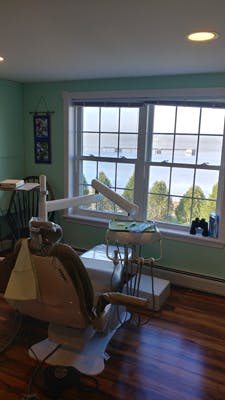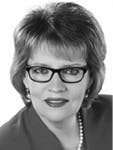I want to be my own boss
By Dianne Glasscoe Watterson, MBA, RDH
Many hygienists can only dream of a day when they own their own dental practice, but business ownership is becoming a reality in more areas of the country. This husband and wife team give hygienists hope that business ownership can be realized when state legislatures remove barriers that block hygienists from owning their own practices.
Derrick and Anna Robertson are dental hygienists who reside in Bucksport, Maine. They met while attending hygiene school at the University of Maine at Augusta, Bangor Campus.
“I craftily dreamt up excuses to talk to Anna, and we started dating the beginning of my last semester,” Derrick said. Anna was homeschooled, and then headed straight to college. Dental hygiene was a second career for Derrick. He had previously worked as a marketing associate for Sysco Foods and as a service writer for an auto center. Derrick graduated from dental hygiene school in 2003 and Anna in 2005.
One of the operatories in the Robertsons’ practice with a beautiful summertime view.
Making it legal
In July 2008, the Maine legislature passed a bill that allowed for the independent practice of dental hygiene. The application statutes for independent practice dental hygienists (IPDH) state that hygienists are required to have worked in a clinical setting for at least two years and 2,000 hours before they can apply for their license if they have a bachelor’s degree, or six years and 5,000 hours if they have an associate’s degree. Applicants must retake the jurisprudence exam, pass a criminal background check, and pass a board interview. At present, there are approximately 100 IPDHs.
Allowable duties for an IPDH include:
• Interview patients and record complete medical and dental histories
• Take and record the vital signs of blood pressure, pulse, and temperature
• Perform oral inspections, recording all conditions that should be called to the attention of a dentist
• Perform complete periodontal and dental restorative charting
• Perform all procedures necessary for a complete prophylaxis, including root planing
• Apply fluoride to control caries
• Apply desensitizing agents to teeth
• Apply topical anesthetics
• Apply sealants
• Smooth and polish amalgam restorations, limited to slow-speed application only
• Cement pontics and facings outside of the mouth
• Take impressions for athletic mouth guards and custom fluoride trays
• Place and remove rubber dams
• Place temporary restorations in compliance with the protocol adopted by the board
• Apply topical antimicrobials, including fluoride but excluding antibiotics, for the purposes of bacterial reduction, caries control, and desensitization in the oral cavity
• Expose and process radiographs, including but not limited to vertical and horizontal bitewing films, periapical films, panoramic images, and full-mouth series, under protocols developed by the board as long as the IPDH has a written agreement with a licensed dentist that provides that the dentist is available to interpret all dental radiographs within 21 days from the date the radiograph is taken, and that the dentist will sign a radiographic review and findings form
• Prescribe, dispense, or administer anticavity toothpastes or topical gels with 1.1% or less sodium fluoride and oral rinses with 0.05%, 0.2%, 0.44%, or 0.5% sodium fluoride, as well as chlorhexidine gluconate oral rinse. For the purposes of this paragraph, “topical” includes superficial and intraoral application.1
Practice standards
An IPDH has the duties and responsibilities set out in this subsection with respect to each patient seen in an independent capacity.
a. Prior to an initial patient visit, an IPDH shall obtain from the patient or the parent or guardian of a minor patient written acknowledgment of the patient’s or parent’s or guardian’s understanding that the IPDH is not a dentist and that the service to be rendered does not constitute restorative care or treatment.
Anna and Derrick Robertson outside of their practice
b. An IPDH shall provide to a patient or the parent or guardian of a minor patient a written plan for referral to a dentist for any necessary dental care. The referral plan must identify all conditions that should be called to the attention of the dentist.1
Desire and impetus
Derrick had worked for a general dentist for nine years before gaining independent status. The dentist was unable to sell the practice, and Derrick mentioned that he might be willing to take it over as a “hygiene only” office if an interested buyer did not come forward. Derrick felt as though it was a worthy venture, and on September 30, 2013, he and Anna embarked on a journey into ownership.
Inquiring minds . . .
Here are some questions I asked Derrick.
What is the prevailing mood of dentists toward IPDH? How did you get a dentist to join in with you?
The mood or acceptance of IPDHs, in my experience, has been overwhelmingly positive. I’m aware of a few dentists who do not look favorably on hygienist-owned practices, but I feel they may have the wrong impression of our scope of practice. I rely on my fellow general dentists and specialists in so many ways. We coordinate very well with our local periodontists, endodontists, pediatric dentists, and orthodontists.
What my office offers a general dentist is both unique and lucrative, which is why we’ve been able to keep a dentist at our practice since day one. My business provides preventive services such as sealants, routine prophylaxis, radiology, and even more advanced therapy such as nonsurgical periodontal therapy and the occasional temporary filling until the dentist can perform a repair.
Our arrangement with the dentist is not a profit share or commission situation. We charge the dentist a flat-rate low monthly fee for facility usage. This includes the use of our Dentrix system, the receptionist for billing and scheduling, and any of our equipment needed to perform dentistry. This allows a dentist to come in and deliver quality dentistry without having to invest a tremendous amount of money to see a favorable profitability. For this reason, we’ve never been a single day without a dentist in our facility.
The Robertsons’ practice is located in the Maine coastal town of Bucksport
Tell us about your office and staff. What was your most expensive piece of equipment?
We have four operatories—two for hygiene and two for restorative dentistry. There are plans in the works for a fifth operatory, which will be used either as a surgical suite or third hygiene operatory. We currently employ an office manager/receptionist, a full-time hygiene assistant/sterilization tech, and two full-time hygienists. We are open Monday through Thursday, 7 a.m. to 5 p.m., with additional hours on Friday if needed. The most expensive equipment purchase thus far is the Schick Sirona digital x-ray system, which cost roughly $21,000. At our current location, we have a new Statim 5000 G4 sterilizer, a Schick digital system with Nomad portable x-ray generator, and we recently purchased two new dental chairs.
I have operated both as a lessee of a complete dental office and built a dental practice from scratch. At the previous location, I paid slightly less for the monthly lease but was responsible for all expenses. At our current location, all expenses except phone and internet are covered. Building a new office is quite expensive. In the last two years we have invested more than $100,000 into the practice, not including what our dentist/business partner has invested.
Now that you have your own practice, share some of your challenges and things that bring satisfaction.
There are many challenges. When we first took the reins, we were unable to perform radiology since there was a piece of legislation in our way. IP hygiene was only allowed to do x-rays if the area was deemed underserved. With help from state government, we were able to get our area redesignated as underserved. I provided testimony along with a few colleagues, including Lorraine Porter Klug, Eric McMaster, and Catherine Thomas Kasprak, to name a few. This ultimately resulted in the overturning of all unnecessary radiology statutes.
Many things to do with our independent office bring me satisfaction. When we took over, there were around 2,800 active patients. We now have well over 4,000 active patients and average 32 new patients per month. With this, there is also an obvious increase in our personal income. What gives me the most pride is the happiness of our patients. We have seen three dentists come and go, and through it all, our patients have been so understanding and loyal. They have trusted us to do what is best and take care of their dental needs. For this, I will be forever grateful and humbled. I have spent 14 years working in this town and I never want to work anywhere else.
How have you built your patient base?
We built our patient base nearly 100% by word of mouth. I spend probably less than $500 per year on advertising, and most of that is in the form of charitable donations. We take a tremendous amount of pride in the work we do and strive to see that every single patient has his or her needs met. We go to great lengths to improve the patient experience by providing a clean, modern, friendly atmosphere with absolutely beautiful views.
What barriers still exist for you as a practice owner?
Barriers still exist in the form of statutes. We cannot provide local anesthesia, as we are not considered under direct supervision of a dentist, although we do have a dentist on site and are fully capable of handling medical emergencies.
Another barrier is that I could not hire a dental auxiliary to take x-rays other than another dental hygienist, although we are not legally permitted to evaluate them. This, rightfully so, must be done by a licensed dentist. However, we will soon be able to hire a dental auxiliary to expose x-rays. The legislation has already passed (LD 1085). Fortunately, my wife is the best dental hygienist I have ever worked with, and she has her independent status.
Yet another barrier is that there are still a very few insurance companies that will not reimburse us since we are not dentists. This stems from a misunderstanding that we are providing dentistry in some cases. Sometimes, it’s just a matter of a computer software issue or individual state restrictions.
Thinking toward the future, what else would you like to do to grow your business?
I would love to have another location. If an opportunity presents itself in a neighboring town, I would consider opening another office. However, this is at best a distant goal as we are very content in our office here in Bucksport.
Please share anything you’d like readers to know about IP in general and your practice specifically.
We have a Main Street office in the waterfront of historic Bucksport, Maine. Outside our operatory windows in the summertime are seagulls, sailboats, and birds of prey, and we even had a visit from a whale last November. IP has been the most amazing, trying, stressful, yet overwhelmingly rewarding thing I’ve done with my hygiene career. I’d like to tell all my dental hygiene colleagues that you, as a hygienist, are a front-line practitioner. You are capable of helping others, changing people’s points of view, and building habits with your patients that will go with them throughout their lives and improve their oral health. Don’t be afraid to take risks to realize your true potential!
Final thoughts
The idea of a dental hygienist practicing without the oversight of a dentist is a concept that appears to be gaining traction. Many people in the US are underserved dentally, and legislators are realizing that dental hygienists are ready, willing, and able to fill the gap, but only after appropriate legislation allows for independent or alternative practice. Dental practice ownership by a dental hygienist is just one more piece of the puzzle. As the Robertsons demonstrate, the time for this idea is now!
Reference
1. Maine Revised Statutes. Title 32, Chapter 143. http://legislature.maine.gov/statutes/32/title32sec18375.html. Published November 3, 2017. Accessed August 28, 2018.




